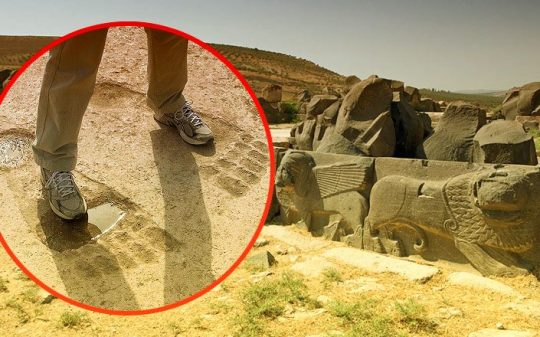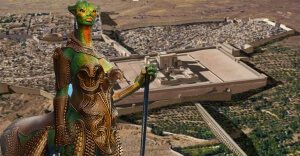Evidence that giants once roamed the land can be found all over the world but are these humongous footprints the real deal?
The ruins of the Ain Dara temple can be found in the eponymous Syrian village located just northwest of Aleppo. Built sometime around 1,300 B.C., this place of worship is similar in architecture and scope to the more famous Solomon’s Temple.
Archaeologists are unclear about what divinity this temple was dedicated to and the multitude of sculptures and bas-reliefs adorning the walls at the archaeological site make it hard to pick a clear winner. But in order to find the most intriguing and compelling piece of evidence at Ain Dara one needs to look down and watch his step.
Upon arrival and before entering, the curious and keen eye will quickly notice a strange signature. Instead of a welcome mat, there sits a pair of large, bare footprints etched into the stone floors of the temple’s entrance. A third footprint can be found beyond the first two, carved on the threshold, as if to represent the bearer of immense feet’s entrance into the place of worship.
Measuring over 3 feet in length, these footprints would have belonged to a humanoid standing over 60 feet tall! How’s that for a pagan god?
Taken out of context, these carvings are strange enough but when we factor in the whole complex and the representations of deities on site, the mystery gets bumped even further.
You see, archaeologists have long speculated the footprints belonged to one of the gods worshipped at Ain Dara. Sculptures of Ishtar and the Sumerian god of storm Ba’al Haddad adorn the walls but there is a catch: they’re all wearing shoes with curled-up toes. Would a god be required to take off his or her shoes before entering the place erected by their devotees? Highly unlikely. The footprints, one could infer, might belong to someone else entirely.
To believers in alternative history, these footprints serve as a reminder of a time when the ‘gods’ walked the Earth and made it tremble under their heavy feet. The mythology of the greater area surrounding Ain Dara certainly leaves room for this hypothesis as stories of giants and their dealings with mankind abound in the East.
Mesopotamia is widely considered the cradle of civilization so it would make sense to look for the influence of alien gods in the area. And when you look for it, it’s right there, gathering the dust of millennia and still raising eyebrows.
So, what do you think these out of place carvings are – merely artistic representations where the creator messed with proportions or imprints with intent left by ancient giants?
https://www.youtube.com/watch?v=FcJ3Oy5BAcM












I’m very interested in all this stuff.
I believe in Science, but I’m disappointed by the way mainstream science allows ‘forbidden’ areas, eg. Forbidden Archaeology.
I do see though that more mainstream scientists are lending their names to such previously forbidden areas.
If something is not even investigated properly, especially due to initial bias, how can it be discluded?
Erik von Daniken, for example, was widely condemned by the scientific community for his research and ideas, yet now those theories are getting more proper scientific weight behind them, particularly as so much has been discovered in Astronomy and Archaeology etc. in recent years.